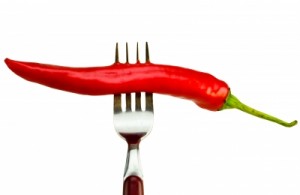by Teresa VanDyk Marshall
Beautiful in a garden, pepper plants add bright colors and rich colored leaves, as well as access to decadent flavors for our favorite spicy dishes. With the exception of bell peppers, most peppers also have a secret ingredient that does more than meets the…tongue—or in the case of pepper spray—the eye.
That secret ingredient is capsaicin.
Typically, we enjoy (or respectfully retreat from) the spicy heat that the capsaicin in peppers brings to our dishes. That “heat” feeling, while it can be very dangerous if misused, happens to be useful to modern medicine. Doctors have been able to harness the powers of capsaicin in patches and injections used to treat chronic pain suffered by arthritic patients. Ironic that an “irritant” has practical use in such a way!
Evidence taken from the British Journal of Nutrition shows cayenne pepper could be helpful in breaking down carbohydrates after a meal, thus helping to regulate blood sugar levels.
In fact, some studies say that capsaicin may improve digestion due to its antibacterial properties. It has been shown to prevent clotting and hardening of the arteries.
Use These Peppers in Your Garden Bird Feeder
Here’s an odd fact about the use of capsaicin in various peppers: use ground chili peppers or crushed dried chilies with birdseed to deter squirrels but keep the birds coming. It turns out that while squirrels and other mammal animals shy away from the peppers, the birds are unaffected by capsaicin and will keep coming back for more!
Pick a Pepper
Peppers come in so many varieties, and they can add such a beautiful, let alone practical, presence to a garden. Some peppers are not grown to be eaten (they are just too hot) but are nonetheless strikingly showy in our garden.
For example, the dark, rich colors of the “Black Pearl” ornamental variety come covered in dark, almost purplish, green leaves. The bush explodes with red, pearl-shaped peppers that turn a shiny black color as they ripen. The “Christmas” pepper plant comes with dark green, waxy leaves and grows little peppers that look just like “Christmas Lights,” often showing off red, yellow, purple and orange peppers all at the same time! (Our only caution when growing these is to keep an eye out for the Whiteflies.) They seem to love  these gorgeous plants as much as we do—except they love them to death. (Regularly spraying with Safer Soap or other organic pest control is highly recommended.)
these gorgeous plants as much as we do—except they love them to death. (Regularly spraying with Safer Soap or other organic pest control is highly recommended.)
So, spice up your garden—and your dinner—thus enjoying vibrant flavors accompanied by improved health. All the while, indulge in the eye candy that these lovely plants will become in your garden.
